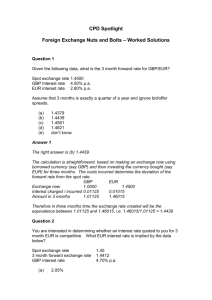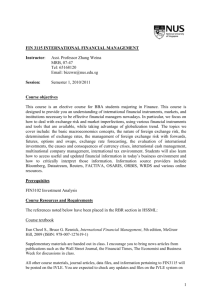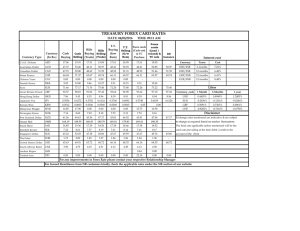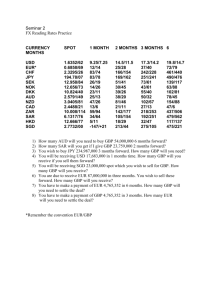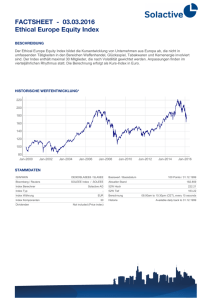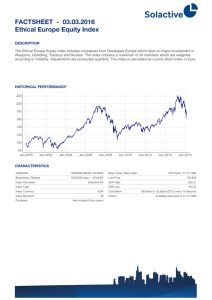Question 1
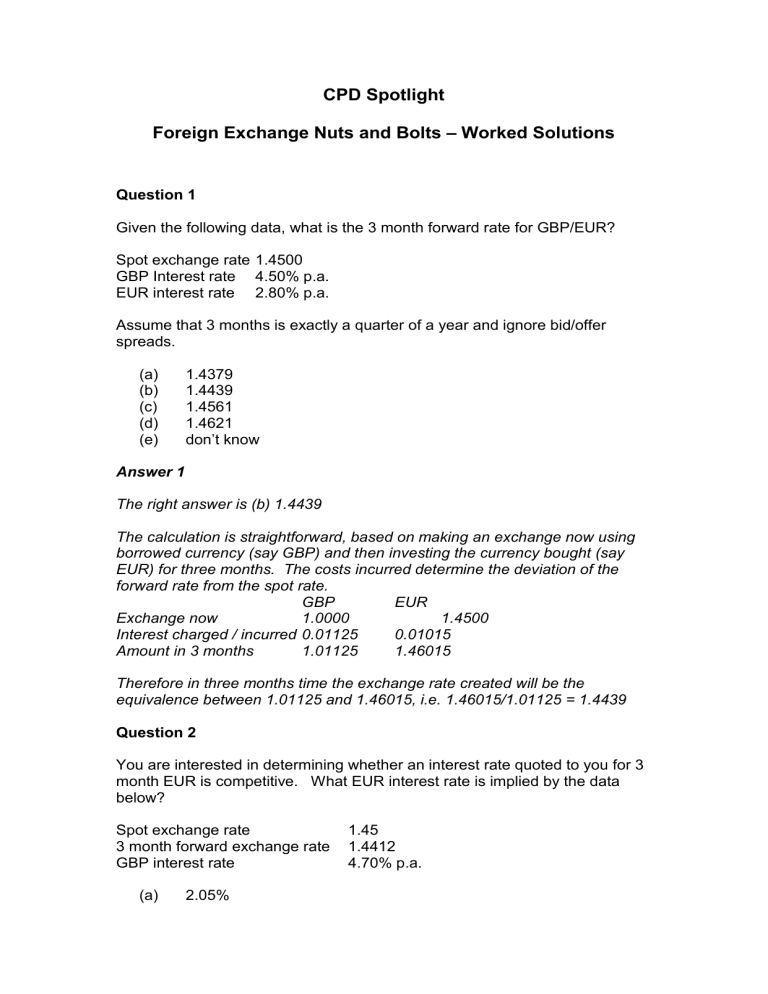
CPD Spotlight
Foreign Exchange Nuts and Bolts – Worked Solutions
Question 1
Given the following data, what is the 3 month forward rate for GBP/EUR?
Spot exchange rate 1.4500
GBP Interest rate 4.50% p.a.
EUR interest rate 2.80% p.a.
Assume that 3 months is exactly a quarter of a year and ignore bid/offer spreads.
(a) 1.4379
(b) 1.4439
(c) 1.4561
(d) 1.4621
(e) don’t know
Answer 1
The right answer is (b) 1.4439
The calculation is straightforward, based on making an exchange now using borrowed currency (say GBP) and then investing the currency bought (say
EUR) for three months. The costs incurred determine the deviation of the forward rate from the spot rate.
Exchange now
GBP
1.0000
Interest charged / incurred 0.01125
Amount in 3 months 1.01125
EUR
1.4500
0.01015
1.46015
Therefore in three months time the exchange rate created will be the equivalence between 1.01125 and 1.46015, i.e. 1.46015/1.01125 = 1.4439
Question 2
You are interested in determining whether an interest rate quoted to you for 3 month EUR is competitive. What EUR interest rate is implied by the data below?
Spot exchange rate 1.45
3 month forward exchange rate 1.4412
4.70% p.a. GBP interest rate
(a) 2.05%
(b) 2.15%
(c) 2.25%
(d) 2.35%
(e) don’t know
Answer 2
The right answer is (c) 2.25%
The principles involved in calculating the interest rate implied by a given forward rate are similar to those in Question 1.
Assume that EUR is bought using borrowed GBP.
Spot exchange
GBP
1.0000
1.4500
After 3 months, the GBP will have accrued interest of 0.01175
The total GBP outstanding is therefore 1.01175
Given that the forward rate is 1.4412, then the corresponding amount of EUR outstanding must be 1.01175 * 1.4412 =
1.45816
The EUR rate implied is thus: ((1.45816/1.4500) – 1) * 4 = 2.251%
EUR
Question 3
You are treasurer of an international company and you are considering whether any translation risk within the group should be managed. Which of the characteristics listed below would be most likely to result in translation risk being important to manage?
(a) a service company with high profits and a low level of fixed assets
(b) a large conglomerate with a portfolio of assets in many currencies
(c) a high asset-intensity business with assets and debt in only two currencies (US$ and CAN$) producing financial statements in US dollars
(d) a medium-sized group with assets in GBP and USD and high borrowings relative to net worth and income
(e) don’t know
Answer 3
The right answer is (d) a medium-sized group with assets in GBP and USD and high borrowings relative to net worth and income
One of the key reasons for managing translation risk is the potential impact on loan covenants, clearly (d) is at risk with high debt relative to both income and the balance sheet. The business referred to in (a) has low assets and high profits and so is unlikely to be affected by its asset base and its profitability implies that covenants will not be a major issue. Business (b) has a portfolio of assets and so is unlikely to experience major volatility from a currency perspective. Business (c) might look risky but these two currencies are often quoted as the lowest volatility pairing and the debt looks matched to assets.
Business (d) has assets in a high volatility currency pair and high debt so its exposure to variation is high coupled with a high potential exposure to a risk of loan covenant breaches.
Question 4
It is often suggested that economic risk is the biggest currency risk faced by corporate treasurers. Which of the following most closely describes economic risk?
(a) a long term cash flow risk relating to uncertain future cash flows
(b) a short term cash flow risk relating to certain future cash flows
(c) a long term non-cash flow risk relating to unrealised values
(d) a short-term non-cash flow risk relating to future non-functional currency profits
(e) don’t know
Answer 4
The right answer is (a) a long-term cash flow risk relating to uncertain future cash flows
Answer (b) refers to transactional risk. Answer (c) and (d) refer to translation risk.
Question 5
You are treasurer of a recent buyout company with high levels of debt, preparing accounts in strerling. You manufacture in Sweden and the United
States where the majority of your assets are located in locally incorporated subsidiaries. Each accounts for roughly 50% of the assets and 50% of currency costs. Sales are generated in mainly in Germany and the US (about
40% in each) plus small amounts in the UK and various other countries.
There is virtually no cross border trade between Europe and the US subsidiaries.
Which currencies would you choose to have debt?
(a) SKR and USD
(b) SKR and EUR
(c) EUR and USD
(d) SKR and USD and EUR
(e)
Don’t know
Answer 5
The right answer is (c) EUR and USD
The key here is to choose whether to use debt to hedge against a probable high level of gearing and hence match debt to assets, or whether to use debt to hedge against cash flow risks and hence match debt to revenues.
Unfortunately, the two are exclusive: if you match assets and debt you need
SKR debt, but that worsens the cash flow position – you already have costs and no revenues in SKR. From a cash flow perspective EUR and USD would match revenues, but would worsen any translation risk by introducing another currency into the balance sheet with no matching asset. Ultimately the decision is which covenant do you want to risk breaching – interest and principal repayment or minimum net worth / maximum gearing. Most people choose to be sure of paying interest on time.
Question 6
You are concerned to hedge a certain single payment in a few months time.
Having checked with the major currency and economic forecasters you have come to the conclusion that you have no idea which direction the currency concerned is taking, but you suspect that economic uncertainty is such that major currency shifts are possible.
In this situation which of the following is most appropriate?
(a) a forward contract gives the best outturn due to its low cost
(b) a currency option gives the best outturn due to its potential for profit, unless the currency shift is marginal
(c) leaving the exposure unhedged gives the best outcome
(d) a currency option is too expensive for consideration
(e) don’t know
Answer 6
The right answer is (b) a currency option gives the best outturn unless the currency shift is marginal.
If you knew which way currencies were going to move you would always either leave the position open or use a forward contract to give the best outturn, and the option will always be the second best outcome because of the premium paid. However, in a world where we do not know the future, the
option gives the best outturn provided that the shift in exchange rate is sufficient to cover the cost of the option.
